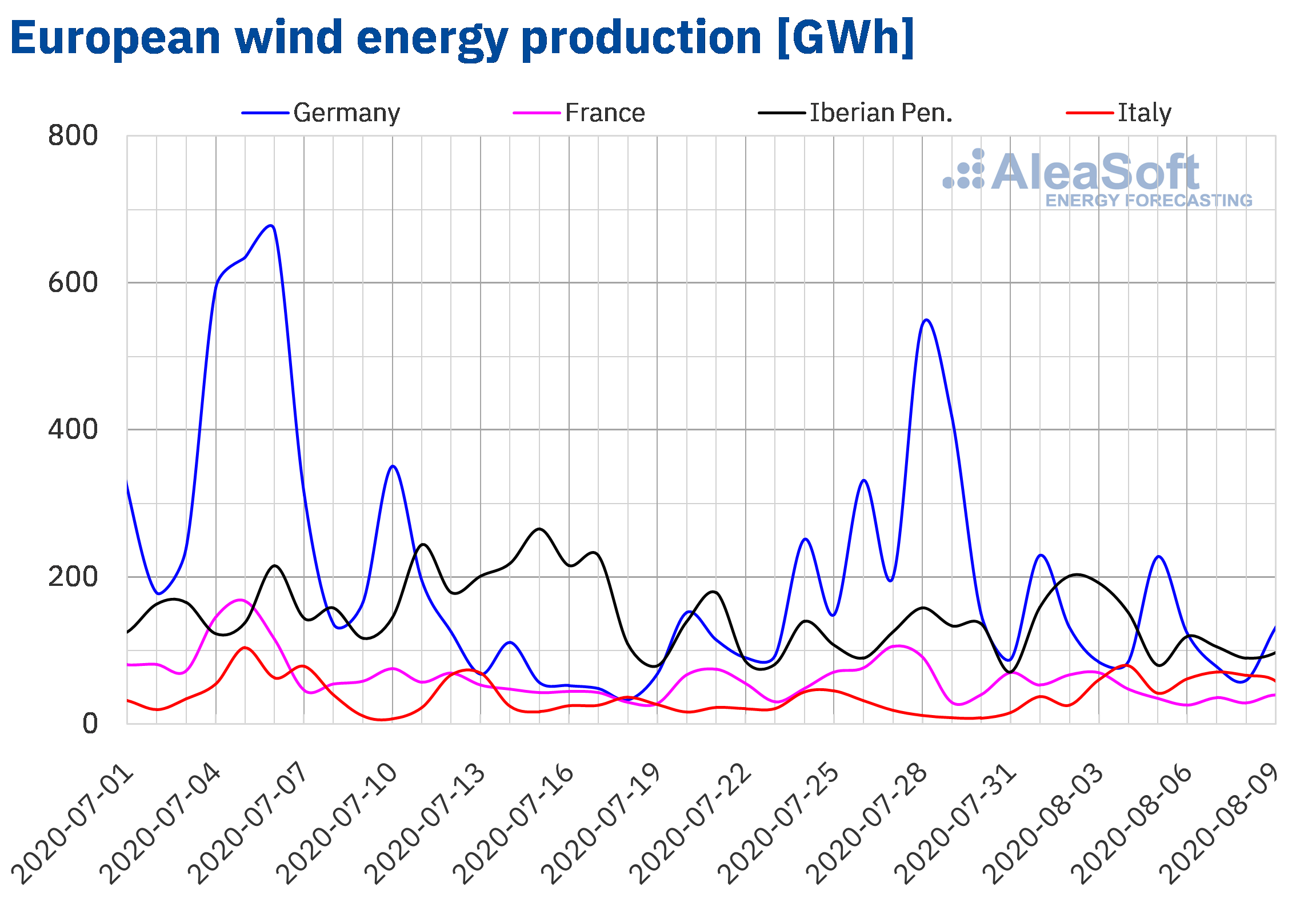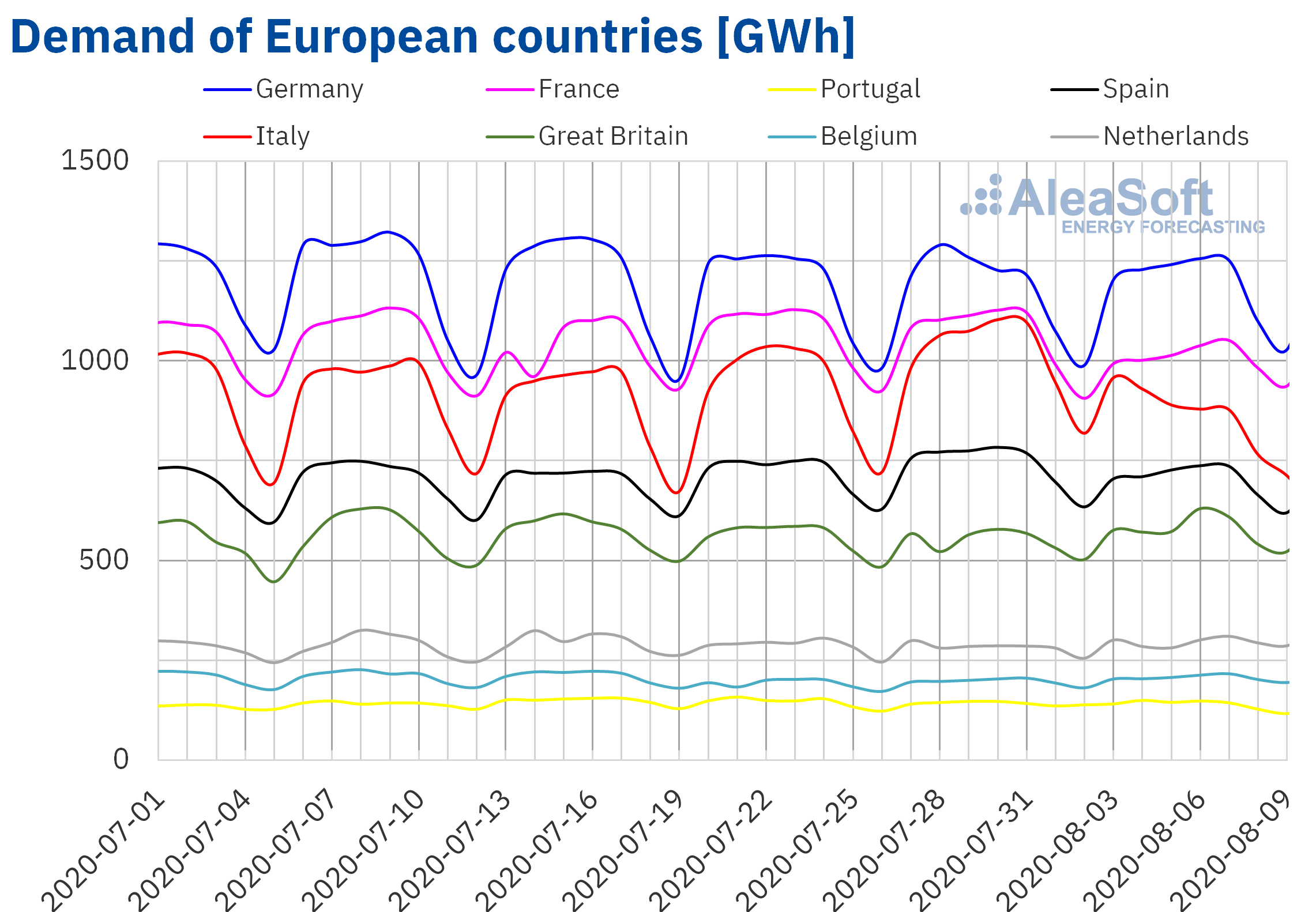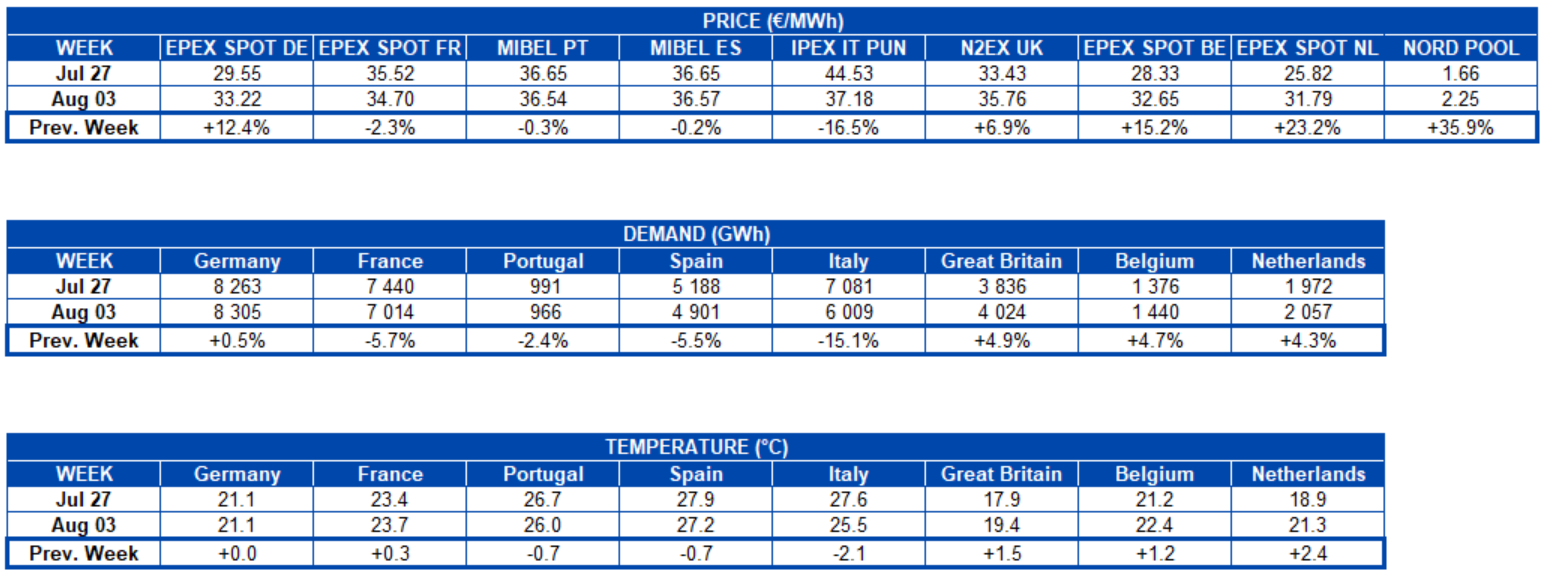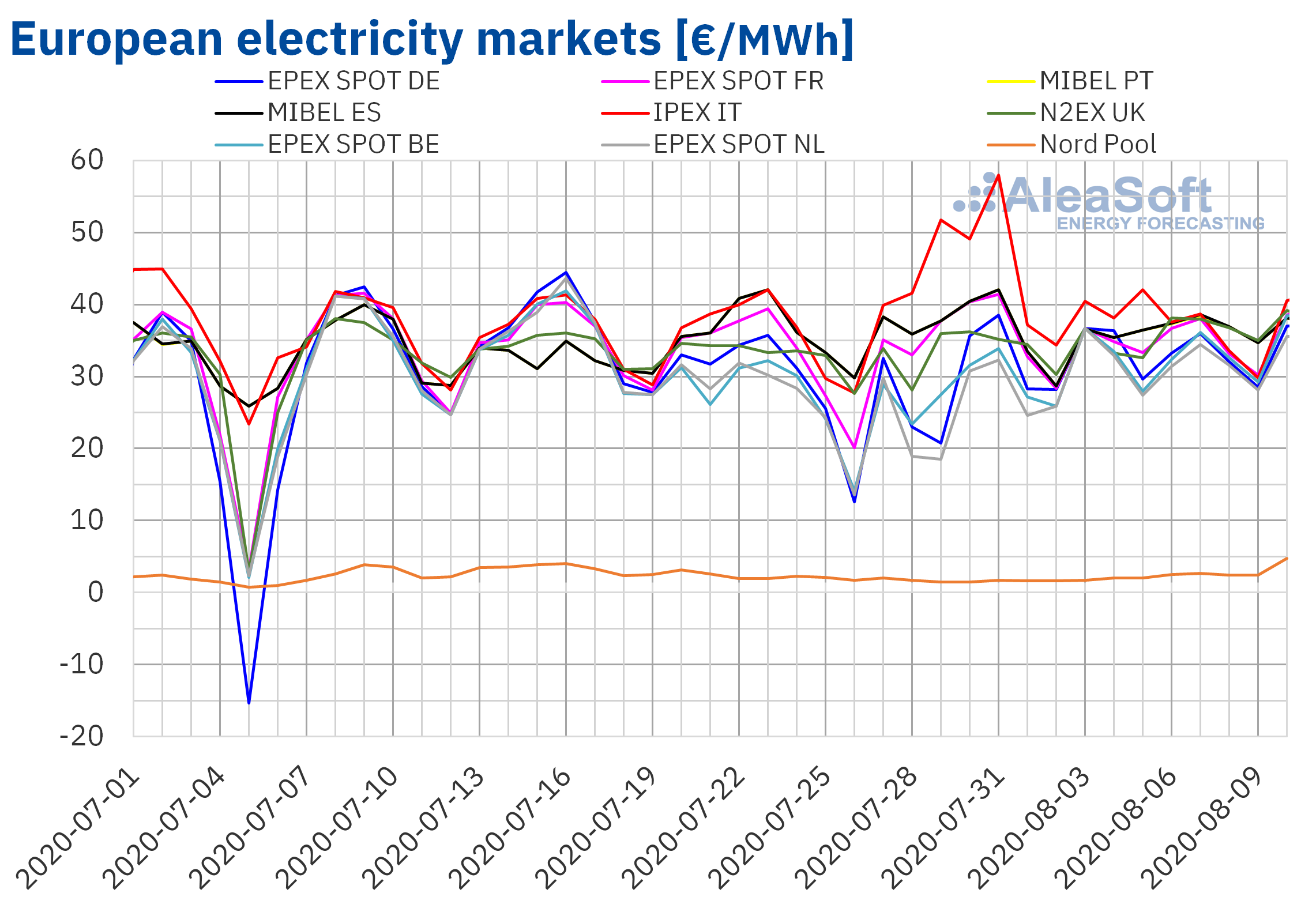AleaSoft, August 10, 2020. The electricity futures prices in the main European countries registered a clear rise in the first week of August with growth exceeding 4% for Cal-21 in some markets. This rise was caused by the increase in the prices of TTF gas and CO2 emission rights, while coal, which recorded price falls, lost weight in the European electricity markets. Photovoltaic energy continues with significant growth rates compared to August 2019.
Solar photovoltaic and solar thermal energy production and wind energy production
The solar energy production during week 32 of 2020 decreased by 12% in the Italian market and 1.7% in the Iberian Peninsula compared to the last week of July. In the German market it increased by 1.4% while in the French market the increase was 6.8%.
During the first 9 days of August, solar energy production in all the markets analysed at AleaSoft was higher than that registered in the same period of 2019. The largest increases in production were registered in the Iberian Peninsula with an increase of 38% in Spain and 39% in Portugal. In the German market, the production increased by 22% and in the French market by 16%. On the other hand, the one with the least increase was the Italian market, with a variation of 0.5%.
For week 33, AleaSoft‘s solar energy production forecasting indicates that German solar energy production should remain especially high, as a heat wave causes temperatures to rise to around 40 °C. In the Italian market, an increase in production is expected, while, on the contrary, in the Spanish market, a decrease in production is expected for the week of August 10.
 Source: Prepared by AleaSoft using data from ENTSO-E, RTE, REN, REE and TERNA.
Source: Prepared by AleaSoft using data from ENTSO-E, RTE, REN, REE and TERNA.
 Source: Prepared by AleaSoft using data from ENTSO-E, RTE, REN, REE and TERNA.
Source: Prepared by AleaSoft using data from ENTSO-E, RTE, REN, REE and TERNA.
Between August 3 and 9, wind energy production increased by 246% in the Italian market compared to week number 32, while, on the contrary, there were decreases in the production of the rest of the markets analysed at AleaSoft. In the German market it decreased by 55%, in the French market by 38% and in the Iberian Peninsula by 15%.
In the year-on-year analysis, between August 1 and 9, wind energy production was 53% higher in the Italian market, while in the Iberian Peninsula it increased by 12% and in the French market, by 3.8%. On the contrary, in the German market, production with this technology was 4.5% lower.
For the week of Monday, August 10, AleaSoft‘s wind energy production forecasting indicates an increase in production in all the analysed markets except the Italian market.
 Source: Prepared by AleaSoft using data from ENTSO-E, RTE, REN, REE and TERNA.
Source: Prepared by AleaSoft using data from ENTSO-E, RTE, REN, REE and TERNA.
Electricity demand
In the first week of August, the electricity demand of the European markets registered both increases and decreases compared to the week of July 27. Changes in average temperatures were influential factors in the variations in demand, where it behaved in the same direction as the temperature in all markets, except in France. As it was forecasted at AleaSoft at the end of the week of August 3, the electricity demand in Italy fell sharply by 15%, mainly due to the beginning of the holiday period and less warm average temperatures of 2.1 °C. Similar decreases of 5.7% and 5.5% were recorded in France and Spain respectively. For its part, in Portugal electricity demand decreased by 2.4%.
Regarding increases, in Great Britain and Belgium there were recoveries of 4.9% and 4.7% in that order, favoured by increases in average temperatures of more than 1.0 °C in both cases. The German market was the one with the lowest variation, 0.5%, with temperatures very similar to those registered during the last week of July.
The decline in electricity demand in Italy can be analysed in more detail in the Italian market observatory at AleaSoft, in conjunction with other market variables.
The AleaSoft‘s electricity demand forecasting indicates that for the week of August 10, demand will increase in most European markets, while in Spain and Portugal it is expected to decrease.
 Source: Prepared by AleaSoft using data from ENTSO-E, RTE, REN, REE, TERNA, National Grid and ELIA.
Source: Prepared by AleaSoft using data from ENTSO-E, RTE, REN, REE, TERNA, National Grid and ELIA.
Electricity markets
During the week of August 3, the prices of most of the European electricity markets were between €31.79/MWh in the EPEX SPOT market of the Netherlands and €37.18/MWh in the IPEX market of Italy. The Nord Pool market of the Nordic countries, which presents a completely different price from the rest of Europe, remained fairly stable throughout the week with an average of €2.25/MWh.
In the first week of August, the market with the highest average price was, as it has been for several weeks, the Italian market, despite registering a drop compared to the average of the last week of July. On the other hand, the Nordic countries market continued to be the one with the lowest price, with a difference of almost €30/MWh compared to the second market with the lowest price, which was the EPEX SPOT market of the Netherlands.

Compared to the prices of the week of July 27, the markets behaved unevenly. Prices increased in the N2EX markets of Great Britain, EPEX SPOT of Germany, Belgium and the Netherlands and Nord Pool of the Nordic countries. In these markets, the registered increases were between 6.9% and 36%. On the other hand, in the MIBEL market of Spain and Portugal, EPEX SPOT of France and IPEX of Italy, prices fell. The Italian market was the one that presented the greatest decrease, of 17%, followed by the French market with a reduction of 2.3%. The MIBEL market in Spain and Portugal was the one with the lowest variation, with decreases of 0.2% and 0.3% respectively.
As for daily prices, during the first week of August, prices in most markets ranged between €27/MWh and €39/MWh. The exception was the Italian market, on Monday and Wednesday the prices were higher than €40/MWh, reaching the maximum price of the week of €42.05/MWh, on August 5. Regarding the Nord Pool market, the daily prices during most of the week remained between €2.00/MWh on Tuesday, August 4 and €2.66/MWh on Friday, August 7, the exception was Monday, August 3, where the lowest daily price of the week was registered, of €1.71/MWh.
 Source: Prepared by AleaSoft using data from OMIE, EPEX SPOT, N2EX, IPEX and Nord Pool.
Source: Prepared by AleaSoft using data from OMIE, EPEX SPOT, N2EX, IPEX and Nord Pool.
The decrease in prices in the Italian market during the first week of August was due to the high wind energy production during that period in conjunction with lower demand, due to temperatures a little less warm than those registered in the last week of July. The latter also influenced the Iberian market. While, in the French market, a lower demand, together with the increase in solar energy production led to the reduction in prices. On the other hand, the increase in demand in the face of warmer temperatures was the fundamental factor that led to the increase in prices in the rest of the markets.

The AleaSoft‘s electricity market prices forecasting indicates that, during the week of August 10, the average weekly prices will be higher in most of the European electricity markets.
Electricity futures
The prices of the European electricity futures for the Q4-20 product registered increases in all the markets analysed at AleaSoft during the recently concluded week of August 3. Analysing the differences between the settlements of the sessions of July 31 and August 7, the NASDAQ market of the Nordic countries was the one with the smallest increase, 0.4%, while the one with the highest variation was the ICE market of the same region, with 11%. This notable difference in the variations of two markets for the same region is due to the fact that in the session of July 31, the prices of the Nordic countries were much far apart between these markets, with the ICE market being more than €1.50/MWh below the NASDAQ market. However, in the session of August 7, prices recovered their usual similarity, distancing themselves by only €0.13/MWh. The rest of the markets had increases of between 7.7% of the ICE market of Great Britain and 3.2% of the EEX market of Germany.
As for the Cal-21 product, a very similar situation occurred, the price rise was generalised, although with more discrete values than in the quarterly product. In the case of EEX markets, the increases were between 1.8% for the Spanish market and 4.0% for the British market. In the OMIP market of Spain and Portugal the variation was 1.7% in both cases. Whereas, in the ICE markets of Great Britain, the Netherlands, Belgium and the Nordic countries, the increases ranged between 4.4% and 1.3%. On the NASDAQ market of the latter, prices increased 2.5% compared to the session of July 31.

Brent, fuels and CO2
In the first three days of the first week of August, the Brent oil futures prices for the month of October 2020 in the ICE market increased. On Wednesday, August 5, a settlement price of $45.17/bbl was registered, the highest since the beginning of March. On Thursday and Friday, prices fell to $44.40/bbl on Friday, August 7, which represented a 1.5% decrease compared to the previous day.
Concerns of lower demand as a result of the increase in the number of infections of COVID‑19 in conjunction with the stagnation in negotiations between the parties in the United States on the economic aid package slightly slowed the recovery of Brent oil futures prices at the end of the week, although the upward trend is clear since the beginning of May.
Regarding the prices of TTF gas futures in the ICE market for the month of September 2020, on Monday, August 3, they registered an increase of 13% compared to Friday, July 31. That day the settlement price was €6.80/MWh, the highest since the second week of July. During the rest of the week, prices remained above €7/MWh, with an upward trend for most of the week and slight decreases of 0.5% and 0.1% on Wednesday and Friday compared to the previous day. A settlement price of €7.94/MWh was reached on Thursday, the highest since April 21. The risk of reduced supply due to the closure of the Australian LNG facility for maintenance caused prices to rebound.
With regard to the TTF gas spot market, the week began with an index price of €5.17/MWh on Monday, August 3. In the following days, prices rose to reach the weekend benchmark price of €7.17/MWh, the highest since the beginning of April. For this Monday, August 10, prices have continued to increase to €7.23/MWh.
On the other hand, the API 2 coal futures prices in the ICE market for the month of September 2020, during the first four days of the first week of August, maintained a downward trend. On Monday, August 3, a price of $52.85/t was reached, the highest of the week, but the rest of the days prices fell to $51.45/t on Thursday, August 6. On Friday prices rose again to $52.05/t.
Regarding the CO2 emission rights futures in the EEX market for the reference contract of December 2020, the first week of August had settlement prices higher than those of the same days of the last week of July and were maintained above €26/t. On Tuesday, August 4, the maximum settlement price of the week of €26.84/t was registered, the highest since July 23. On the other hand, on Monday, August 3, the minimum settlement price for the week was reached, of €26.12/t, which was 4.4% higher than that of Monday, July 27.
 Source: Prepared by AleaSoft using data from ICE and EEX.
Source: Prepared by AleaSoft using data from ICE and EEX.
AleaSoft’s analysis of the energy markets recovery from the economic crisis
The webinar series organised at AleaSoft on “Energy markets emerging from the economic crisis” consists, for the moment, of two parts: the first on September 17 and the second on October 29. Speakers from Deloitte, Engie, Banco Sabadell and AleaSoft have confirmed their presence for these two parts. During the webinars, the evolution and prospects of the energy markets will be analysed at a very delicate moment when the economy begins to recover, but the possibility of outbreaks of the pandemic with the reopening of schools will continue to lurk and, who knows, if even impacting with new measures that will restrict economic, commercial and industrial activity.
Taking into account the current uncertain situation with outbreaks of the pandemic worldwide and the most recent recovery scenarios from the coronacrisis after the publication of the results of the European economies during the second quarter, AleaSoft has updated the long‑term price curves of the European electricity markets.
An interesting tool for monitoring the evolution of the European electricity, fuel and CO2 emission rights markets are the AleaSoft observatories. In them you will find data that is updated daily and that can be viewed in a comparison with the previous weeks, to see its evolution.
This series of webinars will also include analyses on the state of renewable energy projects financing in a situation of significant uncertainty regarding the evolution of markets and prices in the medium term, and the importance of forecasting in audits and in the portfolio valuation.
Source: AleaSoft Energy Forecasting.
